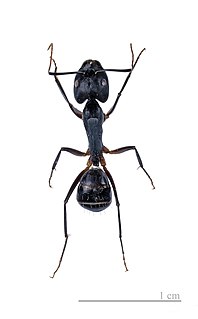
The Formicinae are a subfamily within the Formicidae containing ants of moderate evolutionary development.

Atta is a genus of New World ants of the subfamily Myrmicinae. It contains at least 17 known species.

Aenictogiton is a genus of ants, comprising seven rarely collected species. All of the species are known only from males from Central Africa, and show a morphological and phylogenetic affinity to the army ant genus Dorylus. Nothing is known about the workers, queens, or behavior of these ants. A few undescribed species are known to exist in a few collections.

Dolichoderinae is a subfamily of ants, which includes species such as the Argentine ant, the erratic ant, the odorous house ant, and the cone ant. The subfamily presents a great diversity of species throughout the world, distributed in different biogeographic regions, from the Palearctic, Nearctic, Afrotropical region and Malaysia, to the Middle East, Australian, and Neotropical regions.

Cardiocondyla is an Old World genus of ants in the subfamily Myrmicinae.

Cataglyphis, or desert ants, is a genus of ant in the subfamily Formicinae. Its most famous species is C. bicolor, the Sahara Desert ant, which runs on hot sand to find insects that died of heat exhaustion, and can, like other several other Cataglyphis species, sustain body temperatures of up to 50 °C. Cataglyphis is also the name of an autonomous rover that won the NASA Sample Return Robot Centennial Challenge inspired by the navigation approaches used by desert ants.

Crematogaster is an ecologically diverse genus of ants found worldwide, which are characterised by a distinctive heart-shaped gaster (abdomen), which gives them one of their common names, the Saint Valentine ant. Members of this genus are also known as cocktail ants because of their habit of raising their abdomens when alarmed. Most species are arboreal. These ants are sometimes known as acrobat ants.

Crematogastrini is a tribe of myrmicine ants with 64 genera and 8 fossil genera.

Stereomyrmex is a genus of myrmicine ants. Two of the described species are known from only a single worker, making this one of the rarest groups of ants in the world.

Tetraponera is a genus of ants in the subfamily Pseudomyrmecinae that are commonly known as slender ants and are characterized by their arboreal nature and slender bodies. The 86 described species of Tetraponera all live in hollow structures of plants and trees, such as thorns or branches; these hosts are known as myrmecophytes. Tetraponera species are closely related to the New World genus of ants Pseudomyrmex, but differ in their relationships with host plants.
Cardiocondyla elegans is an ant species in the genus Cardiocondyla found in the Mediterranean region.

Technomyrmex is a genus of ants in the subfamily Dolichoderinae. With 98 species, it is one of the largest and most diverse ant genera in the Dolichoderinae. The genus distributed throughout the tropical and subtropical zones with most species occurring in the Oriental-Malesian and Afrotropical regions. One species, Technomyrmex albipes is a tramp ant now widespread throughout the tropics due to human activities.

Colobostruma is a genus of ants in the subfamily Myrmicinae. All except one species are restricted to Australia. The only non-Australian species, C. foliacea, is found in New Guinea and the Solomon Islands.

Nesomyrmex is a genus of ants in the subfamily Myrmicinae. The genus is distributed in the Neotropical, Afrotropical and Malagasy regions. Most species live in arid climates, but some are known from the rainforest. They nest in soil or in trees. Little is known about their biology.

Carebara is a genus of ants in the subfamily Myrmicinae. It is one of the largest myrmicine genera with more than 174 species distributed worldwide in the tropics and the Afrotropical region. Many of them are very tiny cryptic soil and leaf litter inhabitants. They nest in rotten wood to which the bark is still adherent in the Afrotropical region, or may be lestobiotic nesting near other ant species. Some species are known to exist parasitically within termite nests. Little is known about the biology of the species. However, they are notable for the vast difference in size between queens and workers.
Malagidris is a Malagasy genus of ants in the subfamily Myrmicinae. Described in 2014, the genus contains six species.

Cardiocondyla emeryi is a species of ant in the subfamily Myrmicinae. There are two subspecies recognized. The type subspecies is found in numerous countries, through its large introduced range.

Cardiocondyla minutior is a species of ant in the subfamily Myrmicinae. It is a widespread ant species, and not invasive in nature.




















